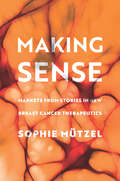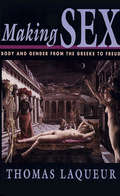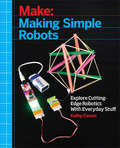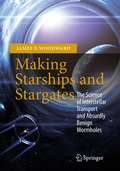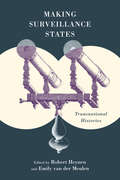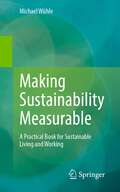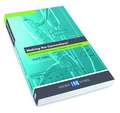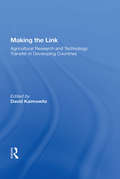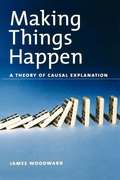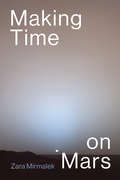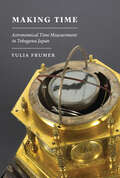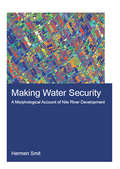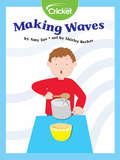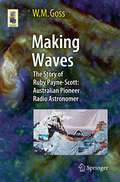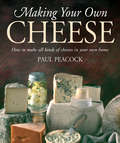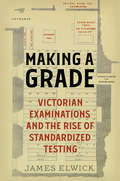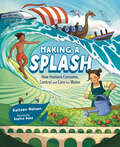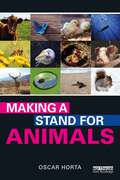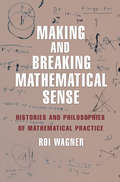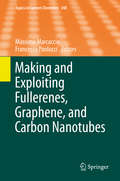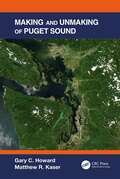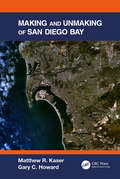- Table View
- List View
Making Sense: Markets from Stories in New Breast Cancer Therapeutics (Culture and Economic Life)
by Sophie MützelBreast cancer is one of the most commonly diagnosed cancers and a leading cause of death for women worldwide. With advances in molecular engineering in the 1980s, hopes began to rise that a non-toxic and non-invasive treatment for breast cancer could be developed. These hopes were stoked by the researchers, biotech companies, and analysts who worked to make sense of the uncertainties during product development. In Making Sense Sophie Mützel traces this emergence of "innovative breast cancer therapeutics" from the late 1980s up to 2010, through the lens of the narratives of the involved actors. Combining theories of economic and cultural sociology, Mützel shows how stories are integral for the emergence of new markets; stories of the future create a market of expectations prior to any existing products; stories also help to create categories on what such a new market and its products are about. Making Sense uses thousands of press statements, media reports, scientific reports, and financial and industry analyses, and combines qualitative and large-scale computational text analyses, to illustrate these mechanisms, presenting a fresh view of how life-prolonging innovations can be turned into market products.
Making Sex: Body and Gender from the Greeks to Freud
by Thomas LaqueurThis is a book about the making and unmaking of sex over the centuries. It tells the astonishing story of sex in the West from the ancients to the moderns in a precise account of developments in reproductive anatomy and physiology. We cannot fail to recognize the players in Thomas Laqueur’s story—the human sexual organs and pleasures, food, blood, semen, egg, sperm—but we will be amazed at the plots into which they have been woven by scientists, political activists, literary figures, and theorists of every stripe. <P><P> Laqueur begins with the question of why, in the late eighteenth century, woman’s orgasm came to be regarded as irrelevant to conception, and he then proceeds to retrace the dramatic changes in Western views of sexual characteristics over two millennia. Along the way, two “masterplots” emerge. In the one-sex story, woman is an imperfect version of man, and her anatomy and physiology are construed accordingly: the vagina is seen as an interior penis, the womb as a scrotum, the ovaries as testicles. The body is thus a representation, not the foundation, of social gender. The second plot tends to dominate post-Enlightenment thinking while the one-sex model is firmly rooted in classical learning. The two-sex story says that the body determines gender differences, that woman is the opposite of man with incommensurably different organs, functions, and feelings. The two plots overlap; neither ever holds a monopoly. Science may establish many new facts, but even so, Laqueur argues, science was only providing a new way of speaking, a rhetoric and not a key to female liberation or to social progress. Making Sex ends with Freud, who denied the neurological evidence to insist that, as a girl becomes a woman, the locus of her sexual pleasure shifts from the clitoris to the vagina; she becomes what culture demands despite, not because of, the body. Turning Freud’s famous dictum around, Laqueur posits that destiny is anatomy. Sex, in other words, is an artifice. <P><P> This is a powerful story, written with verve and a keen sense of telling detail (be it technically rigorous or scabrously fanciful). Making Sex will stimulate thought, whether argument or surprised agreement, in a wide range of readers.
Making Simple Robots
by Kathy CeceriMaking Simple Robots is based on one idea: Anybody can build a robot! That includes kids, English majors, school teachers, and grandparents. If you can knit, sew, or fold a flat piece of paper into a box, you can build a no-tech robotic part. If you can use a hot glue gun, you can learn to solder basic electronics into a low-tech robot that reacts to its environment. And if you can figure out how to use the apps on your smart phone, you can learn enough programming to communicate with a simple robot.Written in language that non-engineers can understand, Making Simple Robots helps beginners move beyond basic craft skills and materials to the latest products and tools being used by artists and inventors. Find out how to animate folded paper origami, design a versatile robot wheel-leg for 3D printing, or program a rag doll to blink its cyborg eye. Each project includes step-by-step directions as well as clear diagrams and photographs. And every chapter offers suggestions for modifying and expanding the projects, so that you can return to the projects again and again as your skill set grows.
Making Space: How the Brain Knows Where Things Are
by Jennifer M. GrohKnowing where things are seems effortless. Yet our brains devote tremendous power to figuring out simple details about spatial relationships. Jennifer Groh traces this mental detective work to show how the brain creates our sense of location, and makes the case that the brain's systems for thinking about space may be the systems of thought itself.
Making Starships and Stargates
by James F. WoodwardTo create the exotic materials and technologies needed to make stargates and warp drives is the holy grail of advanced propulsion. A less ambitious, but nonetheless revolutionary, goal is finding a way to accelerate a spaceship without having to lug along a gargantuan reservoir of fuel that you blow out a tailpipe. Tethers and solar sails are conventional realizations of the basic idea. There may now be a way to achieve these lofty objectives. "Making Starships and Stargates" will have three parts. The first will deal with information about the theories of relativity needed to understand the predictions of the effects that make possible the "propulsion" techniques, and an explanation of those techniques. The second will deal with experimental investigations into the feasibility of the predicted effects; that is, do the effects exist and can they be applied to propulsion? The third part of the book - the most speculative - will examine the question: what physics is needed if we are to make wormholes and warp drives? Is such physics plausible? And how might we go about actually building such devices? This book pulls all of that material together from various sources, updates and revises it, and presents it in a coherent form so that those interested will be able to find everything of relevance all in one place.
Making Surveillance States: Transnational Histories
Making Surveillance States: Transnational Histories opens up new and exciting perspectives on how systems of state surveillance developed over the nineteenth and twentieth centuries. Taking a transnational approach, the book challenges us to rethink the presumed novelty of contemporary surveillance practices, while developing critical analyses of the ways in which state surveillance has profoundly shaped the emergence of contemporary societies. Contributors engage with a range of surveillance practices, including medical and disease surveillance, systems of documentation and identification, and policing and security. These approaches enable us to understand how surveillance has underpinned the emergence of modern states; sustained systems of state security; enabled practices of colonial rule; perpetuated racist and gendered forms of identification and classification; regulated and policed migration; shaped the eugenically inflected medicalization of disability and sexuality; and contained dissent. While surveillance is thus bound up with complex relations of power, it is also contested. Emerging from the book is a sense of how state actors understood and legitimized their own surveillance practices, as well as how these practices have been implemented in different times and places. At the same time, contributors explore the myriad ways in which these systems of surveillance have been resisted, challenged, and subverted.
Making Sustainability Measurable: A Practical Book for Sustainable Living and Working
by Michael WühleMaking something measurable means being able to control it Sustainability is a term with a wealth of meanings and many possible misinterpretations. Yet sustainability can be a powerful and effective tool to guide our practical actions and simplify complicated decisions. Sustainability can save costs and stabilize any organization and company. It protects the climate and the environment and leads all people into a good future. The non-fiction book "Making Sustainability Measurable" is a practical guide on how methods and instruments of sustainability can be used successfully - be it in professional life or in private and voluntary engagement. The book not only provides the interested layperson with a comprehensive overview of the central aspects of sustainability management, it also offers practitioners important decision-making aids and tips for implementation. The easy-to-understand style conveys all the essential contents of the topic of sustainability even to newcomers. Whether you have previous knowledge or not - with the many immediately implementable "best practices", the book offers a lot of practical application possibilities. The appendices contain unrestricted tools from the author's practice for the introduction of successful sustainability management.
Making The Link: Agricultural Research And Technology Transfer In Developing Countries
by David KaimowitzThis book is about International Service for National Agricultural Research's (ISNAR) study to identify key factors that influenced the effectiveness and efficiency of links between research and technology transfer. It recommends ways to improve these links and reflects the progress made till date.
Making Things Happen: A Theory Of Causal Explanation
by James WoodwardWoodward's long awaited book is an attempt to construct a comprehensive account of causation explanation that applies to a wide variety of causal and explanatory claims in different areas of science and everyday life. The book engages some of the relevant literature from other disciplines, as Woodward weaves together examples, counterexamples, criticisms, defenses, objections, and replies into a convincing defense of the core of his theory, which is that we can analyze causation by appeal to the notion of manipulation.
Making Time on Mars (Inside Technology)
by Zara MirmalekAn examination of how the daily work of NASA's Mars Exploration Rovers was organized across three sites on two planets using local Mars time.In 2004, mission scientists and engineers working with NASA's Mars Exploration Rovers (MER) remotely operated two robots at different sites on Mars for ninety consecutive days. An unusual feature of this successful mission was that it operated on Mars time—the daily work was organized across three sites on two planets according to two Martian time zones. In Making Time on Mars, Zara Mirmalek shows that this involved more than a resetting of wristwatches; the team's struggle to synchronize with Mars time involved technological and communication breakdowns, informal workarounds, and extra work to support the technology that was intended to support people. Her account of how NASA created an entirely new temporality for the MER mission offers insights about the assumptions behind the organizational relationship between clock time and work.Mirmalek, herself a member of the mission team, offers an insider's view of the MER workplace and community. She describes the discord among MER's multiple temporalities and examines issues of professional identity that helped shape the experience of working according to Mars time. Considering time and work relationships through a multidisciplinary lens, Mirmalek shows how contemporary and historical human–technology relationships inform assumptions about the unalterability of clock time. She argues that the organizational connection between clock time and work, although still operational, is outdated.
Making Time: Astronomical Time Measurement in Tokugawa Japan (Studies of the Weatherhead East Asian Institute)
by Yulia FrumerWhat is time made of? We might balk at such a question, and reply that time is not made of anything—it is an abstract and universal phenomenon. In Making Time, Yulia Frumer upends this assumption, using changes in the conceptualization of time in Japan to show that humans perceive time as constructed and concrete. In the mid-sixteenth century, when the first mechanical clocks arrived in Japan from Europe, the Japanese found them interesting but useless, because they failed to display time in units that changed their length with the seasons, as was customary in Japan at the time. In 1873, however, the Japanese government adopted the Western equal-hour system as well as Western clocks. Given that Japan carried out this reform during a period of rapid industrial development, it would be easy to assume that time consciousness is inherent to the equal-hour system and a modern lifestyle, but Making Time suggests that punctuality and time-consciousness are equally possible in a society regulated by a variable-hour system, arguing that this reform occurred because the equal-hour system better reflected a new conception of time — as abstract and universal—which had been developed in Japan by a narrow circle of astronomers, who began seeing time differently as a result of their measurement and calculation practices. Over the course of a few short decades this new way of conceptualizing time spread, gradually becoming the only recognized way of treating time.
Making Water Security: A Morphological Account of Nile River Development (IHE Delft PhD Thesis Series)
by Hermen SmitThis book examines Nile water security through the morphology of the river: it uses the always changing form of the river as a theoretical and empirical device to map and understand how infrastructures and discourses dynamically interact with the Nile. By bringing a history of two centuries of dam development on the Nile in relation with the drainage of a hill slope in Ethiopia on the one hand and irrigation reform in Sudan on the other, the author shows how the scales, units and ‘populations’ figuring in projects to securitize the river emerge through the rearrangement of its water and sediments. The analysis of ‘Making water security’ is more than yet another story of how modern projects of water security have legitimized often violent dispossessions of Nile land and water. It shows how no water user is confined by the roles assigned by project engineers and planners. As ongoing modern ‘development’ of the river reduces the prospects for new large diversions of water, the targeted subjects of development and modernization make use of newly opened spaces to carve out their own projects. They creatively mobilize old irrigation and drainage infrastructures in ways that escape the universal logic of water security.
Making Waves
by Amy TaoTry these experiments to learn how sound waves travel through the air to make your eardrums vibrate!
Making Waves: Australian Pioneer Radio Astronomer
by M GossThis book is an abbreviated, partly re-written version of "Under the Radar - The First Woman in Radio Astronomy: Ruby Payne-Scott." It addresses a general readership interested in historical and sociological aspects of astronomy and presents the biography of Ruby Payne-Scott (1912 - 1981). As the first female radio astronomer (and one of the first people in the world to consider radio astronomy), she made classic contributions to solar radio physics. She also played a major role in the design of the Australian government's Council for Scientific and Industrial Research radars, which were in turn of vital importance in the Southwest Pacific Theatre in World War II. These radars were used by military personnel from Australia, the United States and New Zealand. From a sociological perspective, her career offers many examples of the perils of being a female academic in the first half of the 20th century. Written in an engaging style and complemented by many historical photographs, this book offers fascinating insights into the beginnings of radio astronomy and the role of a pioneering woman in astronomy. To set the scene, the first colourfully illustrated chapter presents an overview of solar astrophysics and the tools of the radio astronomer. From the reviews of "Under the Radar": "This is a beautifully-researched, copiously-illustrated and well-written book that tells us much more than the life of one amazing female radio astronomer. It also provides a profile on radar developments during WWII and on Australia's pre-eminent place in solar radio astronomy in the years following WWII. Under the Radar is compelling reading, and if you have taken the time to read right through this review then it certainly belongs on your bookshelf!" (Wayne Orchiston, Journal of Astronomical History and Heritage, March, 2010)
Making Waves: Irving Dardik and His Superwave Principle
by Roger LewinThe biography of a medical maverick who is challenging scientific convention with his astounding approach to achieving and maintaining health.Dr. Irving Dardik's radical notions about how all matter moves in interconnected waves has drawn deep skepticism from physicists, and his early attempts to put his theory into practice in the field of health care got him banned from practicing medicine in the 1990s. But now, after a decade's worth of rigorous research that seems to support Dardik's SuperWave theory, scientists at such esteemed institutions as MIT, Harvard, and Stanford Research International are signing on with Dardik's team to probe the possibilities. For example, Dardik's unique approach to physical exercise, based on his Principle, has achieved some remarkable successes in reversing symptoms of chronic disease.Making Waves weaves together two fascinating stories: Dardik's personal progression from vascular surgeon to scientific iconoclast and pioneer, chronicling his struggle to convince the scientific community to take him seriously; and the evolution of his mind-expanding SuperWave Principle. Colleagues--skeptics as well as supporters--consider the impact of SuperWave theory on current thinking about nature on all scales, from the universe to the subatomic world, and in the realms of biology, applied science, and medicine. The resulting read will interest those concerned with their own health and vitality as well as those curious about the fundamental workings of nature.
Making Your Own Cheese: How to Make All Kinds of Cheeses in Your Own Home
by Paul PeacockNot everyone can keep a cow, but everyone can make cheese. This book shows you the very basic equipment needed to make your own cheese: the ingredients, including different milks, herbs and flavours; how to make a simple cheese; and how to produce some of the worlds speciality cheeses such as Roquefort, Brie and Edam. You will find recipes for making many cheeses at home. Whether you are making a cheese cake, a ricotta-based pudding or a stonking salty blue, this book is a cheese lover s guide to making their own favourite food and there are some recipes for the biscuits to go with it, too.
Making a Grade: Victorian Examinations and the Rise of Standardized Testing
by James ElwickStarting in the 1850s achievement tests became standardized in the British Isles, and were administered on an industrial scale. By the end of the century more than two million people had written mass exams, particularly in science, technology, and mathematics. Some candidates responded to this standardization by cramming or cheating; others embraced the hope that such tests rewarded not only knowledge but also merit. Written with humour, Making a Grade looks at how standardized testing practices quietly appeared, and then spread worldwide. This book situates mass exams, marks, and credentials in an emerging paper-based meritocracy, arguing that such exams often first appeared as "cameras" to neutrally record achievement, and then became "engines" to change education as people tailored their behaviour to fit these tests. Taking the perspectives of both examiners and examinees, Making a Grade claims that our own culture’s desire for accountability through objective testing has a long history.
Making a Splash: How Humans Consume, Control and Care for Water (Orca Timeline)
by Colleen NelsonFrom where we live to what we eat, water plays a vital role in our survival. Since ancient times, water’s life-giving power has inspired people’s spiritual beliefs. It has influenced how humans migrated around the world. Recently, human ingenuity has taken water from a drinking source to an energy source, though not without consequences. As our population grows, cities expand and climate changes, what is the future of water? Innovations are making water equitable and accessible for all. Water warriors, determined to repair, protect and conserve water, are also shifting the mindset from humans needing water to water needing us. Making a Splash: How Humans Consume, Conserve and Care for Water looks at what has been done in the past and what can be done in the future to ensure the health and prosperity of our blue planet. The epub edition of this title is fully accessible.
Making a Stand for Animals
by Oscar HortaEngaging and thought-provoking, this book examines how humans see and treat other animals and argues that we should extend equal consideration and respect to all beings, human and nonhuman alike. Our world is plighted by ‘isms’ such as racism and sexism, but we may have overlooked a very important one: speciesism. Speciesism is a form of discrimination against those who don’t belong to a certain species. It drives us to see nonhuman animals as objects, rather than individuals with their own interests and with the ability to feel and suffer. This book questions all of the assumptions speciesism is based upon. It raises many challenging questions over humans' very complicated attitudes toward other animals. Thinking about how animals are used as well as the suffering of wild animals, and what the future may be for all beings, this book calls for society to seriously take into account the interests of all animals. For all who care about animals, or simply how to make the world a better place, this book is essential reading.
Making and Breaking Mathematical Sense: Histories and Philosophies of Mathematical Practice
by Roi WagnerIn line with the emerging field of philosophy of mathematical practice, this book pushes the philosophy of mathematics away from questions about the reality and truth of mathematical entities and statements and toward a focus on what mathematicians actually do—and how that evolves and changes over time. How do new mathematical entities come to be? What internal, natural, cognitive, and social constraints shape mathematical cultures? How do mathematical signs form and reform their meanings? How can we model the cognitive processes at play in mathematical evolution? And how does mathematics tie together ideas, reality, and applications?Roi Wagner uniquely combines philosophical, historical, and cognitive studies to paint a fully rounded image of mathematics not as an absolute ideal but as a human endeavor that takes shape in specific social and institutional contexts. The book builds on ancient, medieval, and modern case studies to confront philosophical reconstructions and cutting-edge cognitive theories. It focuses on the contingent semiotic and interpretive dimensions of mathematical practice, rather than on mathematics’ claim to universal or fundamental truths, in order to explore not only what mathematics is, but also what it could be. Along the way, Wagner challenges conventional views that mathematical signs represent fixed, ideal entities; that mathematical cognition is a rigid transfer of inferences between formal domains; and that mathematics’ exceptional consensus is due to the subject’s underlying reality.The result is a revisionist account of mathematical philosophy that will interest mathematicians, philosophers, and historians of science alike.
Making and Exploiting Fullerenes, Graphene, and Carbon Nanotubes
by Francesco Paolucci Massimo MarcaccioThe series Topics in Current Chemistry presents critical reviews of the present and future trends in modern chemical research. The scope of coverage is all areas of chemical science including the interfaces with related disciplines such as biology, medicine and materials science. The goal of each thematic volume is to give the non-specialist reader, whether in academia or industry, a comprehensive insight into an area where new research is emerging which is of interest to a larger scientific audience. Each review within the volume critically surveys one aspect of that topic and places it within the context of the volume as a whole. The most significant developments of the last 5 to 10 years are presented using selected examples to illustrate the principles discussed. The coverage is not intended to be an exhaustive summary of the field or include large quantities of data, but should rather be conceptual, concentrating on the methodological thinking that will allow the non-specialist reader to understand the information presented. Contributions also offer an outlook on potential future developments in the field. Review articles for the individual volumes are invited by the volume editors. Readership: research chemists at universities or in industry, graduate students.
Making and Unmaking of Puget Sound
by Gary C. Howard Matthew R. KaserThe Puget Sound is a complex fjord-estuary system in Washington State that is connected to the Pacific Ocean by the Juan de Fuca Strait and surrounded by several large population centers. The watershed is enormous, covering nearly 43,000 square kilometers with thousands of rivers and streams. Geological forces, volcanos, Ice Ages, and changes in sea levels make the Sound a biologically dynamic and fascinating environment, as well as a productive ecosystem. Human activity has also influenced the Sound. Humans built several major cities, such as Seattle and Tacoma, have dramatically affected the Puget Sound. This book describes the natural history and evolution of Puget Sound over the last 100 million years through the present and into the future. Key Features Summarizes a complex geological, geographical, and ecological history Reviews how the Puget Sound has changed and will likely change in the future Examines the different roles of various drivers of the Sound’s ecosystem function Includes the role of humans—both first people and modern populations. Explores Puget Sound as an example of general bay ecological and environmental issues
Making and Unmaking of San Diego Bay
by Gary C. Howard Matthew R. KaserSan Diego Bay is a shallow estuary surrounded by a large population center. Geological forces and changes in sea levels from the last Ice Age combine to make the Bay and the adjacent highlands and mesas. Human activity has also influenced the Bay. Humans built several major cities and filled significant parts of the Bay. This book describes the natural history and evolution of the San Diego Bay Area over the last 50 million years through the present and into the future. Key Features Summarizes a complex geological, geographical, and ecological history Reviews how the San Diego Bay has changed and will likely change in the future Examines the different roles of various drivers of Bay ecosystem function Includes the role of humans—both first people and modern populations—on the Bay Explores San Diego Bay as an example of general bay ecological and environmental issues Related Titles Howard GC and Kaser MR. Making and Unmaking of the San Francisco Bay (ISBN 9781138596726) Wang Y, ed. Remote Sensing of Coastal Environments (ISBN 978-1-1381-1638-2) Gonenc IE, Wolfin JB, eds. Coastal Lagoons: Ecosystem Processes and Modeling for Sustainable Use and Development (ISBN 978-0-3675-7814-5) Mossop E, ed. Sustainable Coastal Design and Planning (ISBN 978-0-3675-7075-0)
Making and Unmaking of the San Francisco Bay
by Gary C. Howard Matthew R. KaserSan Francisco Bay is a shallow estuary surrounded by a large population center. The forces that built it began with plate tectonics and involved the collision of the Pacific and North American plates and the subduction of the Juan de Fuka plate. Changes in the climate resulting from the last ice age yielded lower and then higher sea levels. Human activity influenced the Bay. Gold mining during the California gold rush sent masses of slit into the Bay. Humans have also built several major cities and filled significant parts of the Bay. This book describes the natural history and evolution of the SF Bay Area over the last 50 million years through the present and into the future. Key selling features: Summarizes a complex geological, geographical and ecological history Reviews how the San Francisco Bay has changed and will likely change in the future Examines the different roles and various drivers of Bay ecosystem function Includes the role of humans - both first peoples and modern populations - on the Bay Explores San Francisco Bay as an example of general bay ecolgical and environmental issues
